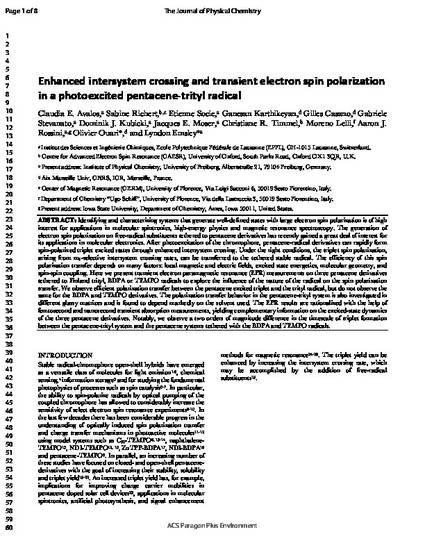
Identifying and characterizing systems that generate well-defined states with large electron spin polarization is of high interest for applications in molecular spintronics, high-energy physics and magnetic resonance spectroscopy. The generation of electron spin polarization on free-radical substituents tethered to pentacene derivatives has recently gained a great deal of interest for its applications in molecular electronics. After photoexcitation of the chromophore, pentacene-radical derivatives can rapidly form spin-polarized triplet excited states through enhanced intersystem crossing. Under the right conditions, the triplet spin polarization, arising from mS-selective intersystem crossing rates, can be transferred to the tethered stable radical. The efficiency of this spin polarization transfer depends on many factors: local magnetic and electric fields, excited state energetics, molecular geometry, and spin-spin coupling. Here we present transient electron paramagnetic resonance (EPR) measurements on three pentacene derivatives tethered to Finland trityl, BDPA or TEMPO radicals to explore the influence of the nature of the radical on the spin polarization transfer. We observe efficient polarization transfer between the pentacene excited triplet and the trityl radical, but do not observe the same for the BDPA and TEMPO derivatives. The polarization transfer behavior in the pentacene-trityl system is also investigated in different glassy matrices and is found to depend markedly on the solvent used. The EPR results are rationalized with the help of femtosecond and nanosecond transient absorption measurements, yielding complementary information on the excited-state dynamics of the three pentacene derivatives. Notably, we observe a two orders of magnitude difference in the timescale of triplet formation between the pentacene-trityl system and the pentacene systems tethered with the BDPA and TEMPO radicals.
Available at: http://works.bepress.com/aaron-rossini/90/

This document is the unedited Author’s version of a Submitted Work that was subsequently accepted for publication in Journal of Physical Chemistry A, copyright © American Chemical Society after peer review. To access the final edited and published work see DOI: 10.1021/acs.jpca.0c03498. Posted with permission.